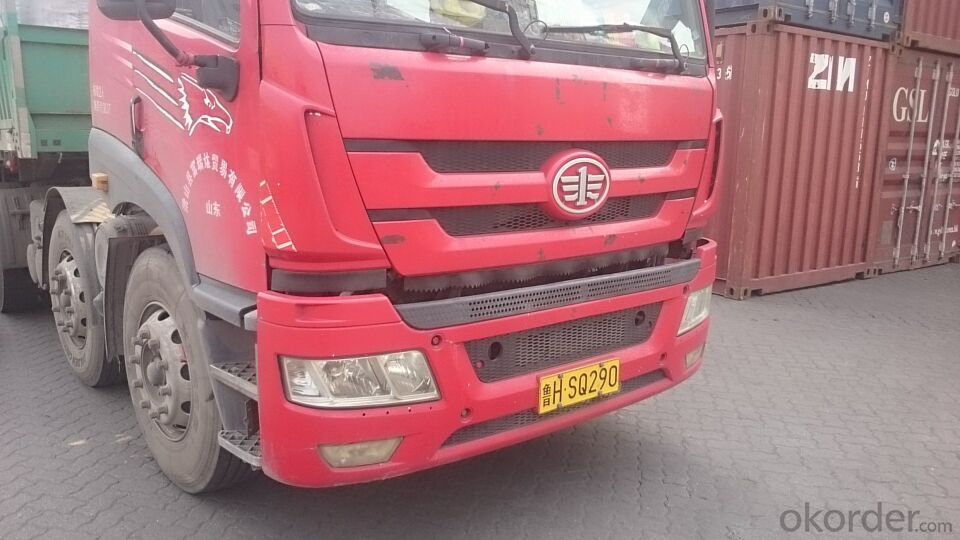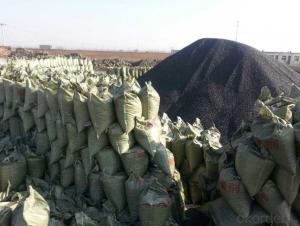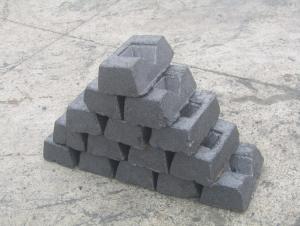Used in EAF as Charge Coke for Steel Mills with Ash 8%max
- Loading Port:
- Tianjin
- Payment Terms:
- TT OR LC
- Min Order Qty:
- 23 m.t.
- Supply Capability:
- 6000 m.t./month
OKorder Service Pledge
OKorder Financial Service
You Might Also Like
Introduction:
Calcined anthracite can be called carbon additive, carbon raiser, recarburizer, injection coke, charging coke, gas calcined anthracite.
Carbon Additive/Calcined Anthracite Coal may substitute massively refinery coke or graphite. Meanwhile its cost is much less than the refinery coke and graphite. Carbon Additive is mainly used in electric steel ovens, water filtering, rust removal in shipbuilding and production of carbon material.
It has good characteristics with low ash, low resistivity, low sulphur, high carbon and high density. It is the best material for high quality carbon products. It is used as carbon additive in steel industry or fuel.
Features:
Best quality Taixi anthracite as raw materials through high temperature calcined at 800-1200 ℃ by the DC electric calciner with results in eliminating the moisture and volatile matter from Anthracite efficiently, improving the density and the electric conductivity and strengthening the mechanical strength and anti-oxidation, It has good characteristics with low ash, low resistivity, low carbon and high density. It is the best material for high quality carbon products, it is used as carbon additive in steel industry or fuel.
Specifications:
F.C.% | 95MIN | 94MIN | 93MIN | 92MIN | 90MIN | 85MIN | 84MIN |
ASH % | 4MAX | 5MAX | 6 MAX | 6.5MAX | 8.5MAX | 12MAX | 13MAX |
V.M.% | 1 MAX | 1MAX | 1.0MAX | 1.5MAX | 1.5MAX | 3 MAX | 3 MAX |
SULFUR % | 0.3MAX | 0.3MAX | 0.3MAX | 0.35MAX | 0.35MAX | 0.5MAX | 0.5MAX |
MOISTURE % | 0.5MAX | 0.5MAX | 0.5MAX | 0.5MAX | 0.5MAX | 1MAX | 1MAX |
Pictures




FAQ:
Packing:
(1). Waterproof jumbo bags: 800kgs~1100kgs/ bag according to different grain sizes;
(2). Waterproof PP woven bags / Paper bags: 5kg / 7.5kg / 12.5kg / 20kg / 25kg / 30kg / 50kg small bags;
(3). Small bags into jumbo bags: waterproof PP woven bags / paper bags in 800kg ~1100kg jumbo bags.
Payment terms
20% down payment and 80% against copy of B/L.
Workable LC at sight,
- Q: What are the advantages of carbon-based fertilizers?
- There are several advantages of carbon-based fertilizers that make them a popular choice among farmers and gardeners. Firstly, carbon-based fertilizers such as compost and manure are organic in nature, which means they are derived from natural sources and do not contain synthetic chemicals. This makes them environmentally friendly and reduces the risk of water pollution or soil degradation. Secondly, carbon-based fertilizers are rich in organic matter, which improves the soil structure and enhances its ability to retain water. This can be particularly beneficial in areas with low soil fertility or frequent droughts, as it helps to conserve moisture and prevent nutrient leaching. Furthermore, carbon-based fertilizers promote the growth of beneficial microorganisms in the soil. These microorganisms break down organic matter and release essential nutrients in a slow and gradual manner, ensuring a steady supply of nutrients to the plants. This improves overall plant health and reduces the risk of nutrient imbalances or deficiencies. Additionally, carbon-based fertilizers are cost-effective in the long run. While they may require more initial effort and time to produce or source, they can be produced on-site through composting or obtained from local sources such as farms or livestock operations. This reduces the need for expensive chemical fertilizers and minimizes transportation costs. Lastly, carbon-based fertilizers contribute to carbon sequestration and help combat climate change. By using organic waste materials as fertilizers, we divert them from landfills where they would emit greenhouse gases. Instead, they are recycled back into the soil, increasing its carbon content and promoting soil health. Overall, carbon-based fertilizers offer numerous advantages in terms of sustainability, soil fertility, cost-effectiveness, and environmental impact. Their use can contribute to healthier plants, improved soil quality, and a more sustainable and resilient agricultural system.
- Q: What is carbon Yi virus?
- Not viruses, anthrax bacillus, anthraci (Bacillus) belongs to aerobic bacillus, can cause sheep, cattle, horses and other animals and human anthrax. Anthrax was as lethal agents of imperialism. Herdsmen, farmers, furs and butchers are susceptible to infection at ordinary times. Skin anthrax is sporadic in our country, so we should not relax our vigilance. Biological characters (1) morphological staining: Bacillus anthracis is thick and ends are flat or sunken. Are like bamboo like, no power, no flagella, gram positive bacteria, the in sufficient oxygen, suitable temperature (25 to 30 DEG C) condition to form spores. No spores can be formed in living or dissected bodies. Spore oval, located in the middle of the bacteria, its width is less than the width of bacteria. Capsules can be formed in humans and animals, and in capsules incubated with CO2 and serum, they can also form capsules. The formation of capsules is a toxic feature. Bacillus anthracis is affected by a low concentration of penicillin, and bacteria can be enlarged to form a bead, called "beaded reaction"". This is also a unique reaction of Bacillus anthracis. (two) the culture characteristic of this bacterium is obligate aerobic, and it is easy to breed in common medium. The optimum temperature was 37 DEG C, and the optimum pH was 7.2 ~ 7.4. After 24 hours on agar plate, the rough colony of 2 ~ 4mm Diameter was developed. The colonies were ground glass like, irregular edge, like curly hair, there are one or several small tail processes, this is the expansion of reproduction in 5 caused by bacteria to 10% sheep blood agar plate, no obvious hemolysis ring around the colony, but a long culture can have mild hemolysis.
- Q: Is graphite carbon?
- Chemically, it belongs to carbonWhen these carbon atoms connect with each other to form a single substance, they have different ways. They are arranged in eight planes. The net shape is the diamond, which is arranged in a regular hexagon and a layer, and then graphite is formedDiamond and graphite are carbon elements
- Q: How does carbon impact the acidity of rainfall?
- The acidity of rainfall is influenced by carbon, which causes acid rain. Acid rain is formed when carbon dioxide (CO2) is released into the atmosphere and combines with water (H2O) to create carbonic acid (H2CO3). This natural reaction has been significantly amplified by human activities like burning fossil fuels and industrial processes, resulting in increased levels of carbon dioxide in the atmosphere. Once carbonic acid is formed, it can further react with other compounds in the air, such as sulfur dioxide (SO2) and nitrogen oxides (NOx), leading to the formation of stronger acids like sulfuric acid (H2SO4) and nitric acid (HNO3). These acids then dissolve in rainwater and produce acid rain. The presence of carbon in the atmosphere contributes to the overall acidity of rainfall. Acid rain has harmful effects on the environment, ecosystems, and human health. It causes damage to forests, lakes, and rivers, leading to the decline of fish populations and destruction of habitats. Additionally, acid rain corrodes buildings and monuments, erodes metals, and harms crops. The impact of carbon on the acidity of rainfall emphasizes the significance of reducing carbon emissions and addressing climate change. By transitioning to cleaner energy sources, implementing sustainable practices, and reducing our carbon footprint, we can help mitigate the acidity of rainfall and minimize the negative consequences associated with acid rain.
- Q: What are carbon-based superconductors?
- Superconductivity, a phenomenon where electrical resistance drops to zero at low temperatures, is exhibited by carbon-based superconductors. Unlike conventional superconductors, which are typically metallic elements or alloys, carbon-based superconductors are primarily composed of carbon atoms. These materials possess a unique structure and properties that make them efficient conductors of electricity when cooled below a critical temperature. Carbon-based superconductors can be divided into two main types: organic superconductors and fullerene superconductors. Organic superconductors consist of carbon-based molecules, such as organic salts or polymers, that form a crystal lattice structure. Extensive research has been conducted on these materials, revealing promising superconducting properties at low temperatures. On the other hand, fullerene superconductors are composed of carbon molecules arranged in a cage-like structure called fullerenes. The most famous fullerene is C60, also known as a buckyball, which has 60 carbon atoms arranged in a soccer ball-like shape. By doping these fullerene cages with specific elements like alkali metals or transition metals, their superconducting properties can be enhanced. What makes carbon-based superconductors particularly fascinating is their potential for high-temperature superconductivity. While most conventional superconductors require extremely low temperatures close to absolute zero (-273.15°C or -459.67°F) to exhibit superconductivity, certain carbon-based superconductors have been found to retain their superconducting properties at relatively higher temperatures. This characteristic is significant for practical applications as it facilitates easier cooling and opens up possibilities for widespread use of superconductivity in fields like energy transmission, magnetic levitation, and quantum computing. However, it is crucial to note that carbon-based superconductors are still an active research area, and numerous challenges remain in understanding their mechanisms and enhancing their superconducting properties. Nevertheless, the discovery and exploration of these materials hold great promise for advancing the field of superconductivity and enabling new technological breakthroughs.
- Q: What are the properties of carbon nanotubes?
- Carbon nanotubes are a unique form of carbon with exceptional properties. They are incredibly strong and have a high tensile strength, making them stronger than steel but much lighter. They also have excellent thermal and electrical conductivity, allowing for efficient heat dissipation and electrical conduction. Carbon nanotubes possess a large surface area, enabling them to be used for various applications such as energy storage, water filtration, and drug delivery systems. Additionally, they exhibit remarkable flexibility and can be manipulated into different shapes and structures, making them highly versatile in nanotechnology and materials science.
- Q: How does carbon impact the energy balance of the Earth?
- The energy balance of the Earth is primarily influenced by carbon, which plays a significant role in the greenhouse effect. Carbon dioxide, a greenhouse gas, is emitted into the atmosphere through both natural processes and human activities such as the burning of fossil fuels and deforestation. The greenhouse effect occurs naturally when specific gases in the atmosphere trap heat from the sun, preventing it from escaping back into space. This process is essential for maintaining a suitable temperature for life on Earth. However, excessive carbon emissions have intensified the greenhouse effect, resulting in global warming and climate change. When carbon dioxide and other greenhouse gases accumulate in the atmosphere, they trap more heat, causing the Earth's surface temperature to rise. This temperature increase disrupts the planet's energy balance, leading to the melting of polar ice caps, rising sea levels, and more frequent and severe extreme weather events. Moreover, carbon alters the energy balance of the Earth by impacting the carbon cycle. The carbon cycle is a natural process in which carbon is exchanged between the atmosphere, oceans, and land. However, human activities have significantly disrupted this cycle by releasing large quantities of carbon into the atmosphere, primarily through the combustion of fossil fuels. Excessive carbon emissions create an imbalance in the carbon cycle, as the natural processes that absorb and store carbon, such as photosynthesis and the ocean's ability to absorb CO2, cannot keep up with the rate of emissions. This leads to an accumulation of carbon dioxide in the atmosphere, further intensifying the greenhouse effect and contributing to global warming. In conclusion, carbon has a significant impact on the energy balance of the Earth by intensifying the greenhouse effect and disrupting the natural carbon cycle. It is crucial to reduce carbon emissions and transition to cleaner and more sustainable energy sources in order to mitigate the adverse effects of carbon on the planet's energy balance. Ultimately, this is necessary to preserve the health and stability of our environment.
- Q: What are the effects of carbon emissions on the stability of peatlands?
- Carbon emissions have significant effects on the stability of peatlands, leading to various environmental and ecological consequences. Peatlands are wetland ecosystems composed of partially decomposed organic matter, primarily consisting of dead plants and mosses. These ecosystems are known as important carbon sinks, storing large amounts of carbon in the form of plant material and organic peat. When carbon emissions, particularly from the burning of fossil fuels, are released into the atmosphere, it contributes to the overall increase in greenhouse gases, such as carbon dioxide (CO2) and methane (CH4). This increase in greenhouse gases leads to global warming and climate change, which have direct impacts on peatlands. One of the primary effects of carbon emissions on peatlands is the acceleration of peat decomposition. As temperatures rise due to global warming, the rate of microbial activity in peatlands increases, resulting in faster decomposition of organic matter. This process releases carbon dioxide and methane, further contributing to greenhouse gas emissions. The increased decomposition can also lead to the subsidence or sinking of peatlands, which affects their stability and can contribute to land degradation. Additionally, carbon emissions can alter the hydrology of peatlands. Rising temperatures can cause increased evaporation and reduced precipitation, leading to drier conditions in peatlands. This can result in water tables dropping below the surface, which inhibits the growth of mosses and the accumulation of new peat. As a result, peatlands become less capable of sequestering carbon and can even transition into carbon sources rather than sinks. The destabilization of peatlands due to carbon emissions has cascading effects on the overall ecosystem. Peatlands provide habitats for numerous plant and animal species, many of which are unique and highly adapted to these specific environments. The drying and sinking of peatlands can disrupt these ecosystems, leading to changes in the composition and distribution of species, as well as increased susceptibility to invasive species. Furthermore, the release of carbon dioxide and methane from peatlands contributes to the amplification of climate change. These greenhouse gases trap heat in the atmosphere, leading to further warming and exacerbating the cycle of peat decomposition and carbon emissions. In conclusion, carbon emissions have detrimental effects on the stability of peatlands, including accelerated peat decomposition, altered hydrology, and disruption of ecosystems. These impacts not only hinder peatlands' ability to sequester carbon but also contribute to climate change, creating a negative feedback loop. It is crucial to reduce carbon emissions and prioritize the preservation and restoration of peatlands to mitigate these effects and protect these valuable ecosystems.
- Q: What is the importance of carbon dating in archaeology?
- Carbon dating is of utmost importance in archaeology as it plays a crucial role in determining the age of artifacts and archaeological sites. This scientific method allows archaeologists to establish a chronological framework and understand the timeline of human history. The technique of carbon dating relies on the fact that all living organisms contain a certain amount of radioactive carbon-14, which decays at a predictable rate over time. By measuring the amount of carbon-14 remaining in an artifact or organic material, archaeologists can calculate its age. This method is particularly useful for dating organic remains, such as bones, charcoal, and plant fibers, which are often found at archaeological sites. The importance of carbon dating lies in its ability to provide a precise and reliable estimation of an artifact's age. This information is crucial for interpreting and understanding the context and significance of archaeological finds. By assigning an accurate date to an object or site, archaeologists can establish connections between different artifacts, societies, and cultures. This, in turn, helps to reconstruct ancient civilizations and their development over time. Furthermore, carbon dating is also valuable for refining and validating historical timelines. It allows archaeologists to cross-reference and verify the dating of artifacts and sites using other dating methods, such as dendrochronology (tree-ring dating) or stratigraphy (the study of rock layers). The combination of multiple dating techniques enhances the accuracy and reliability of archaeological interpretations. Carbon dating also assists in identifying and distinguishing between genuine artifacts and forgeries. By analyzing the age of an object, archaeologists can determine if it aligns with the historical context it claims to belong to. This is particularly important in the field of art and antiquities, where the market for fakes and forgeries can be lucrative. Overall, carbon dating is a vital tool in archaeology as it allows researchers to establish the chronology of ancient civilizations, validate historical timelines, and identify genuine artifacts. It provides valuable insights into our past, helping us better understand and appreciate the rich tapestry of human history.
- Q: What is the structure of graphite, another form of carbon?
- Graphite has a layered structure where carbon atoms are arranged in hexagonal rings, forming sheets of interconnected hexagons. These sheets are stacked on top of each other, with weak forces of attraction between them, resulting in a slippery and flaky structure.
Send your message to us
Used in EAF as Charge Coke for Steel Mills with Ash 8%max
- Loading Port:
- Tianjin
- Payment Terms:
- TT OR LC
- Min Order Qty:
- 23 m.t.
- Supply Capability:
- 6000 m.t./month
OKorder Service Pledge
OKorder Financial Service
Similar products
Hot products
Hot Searches


























